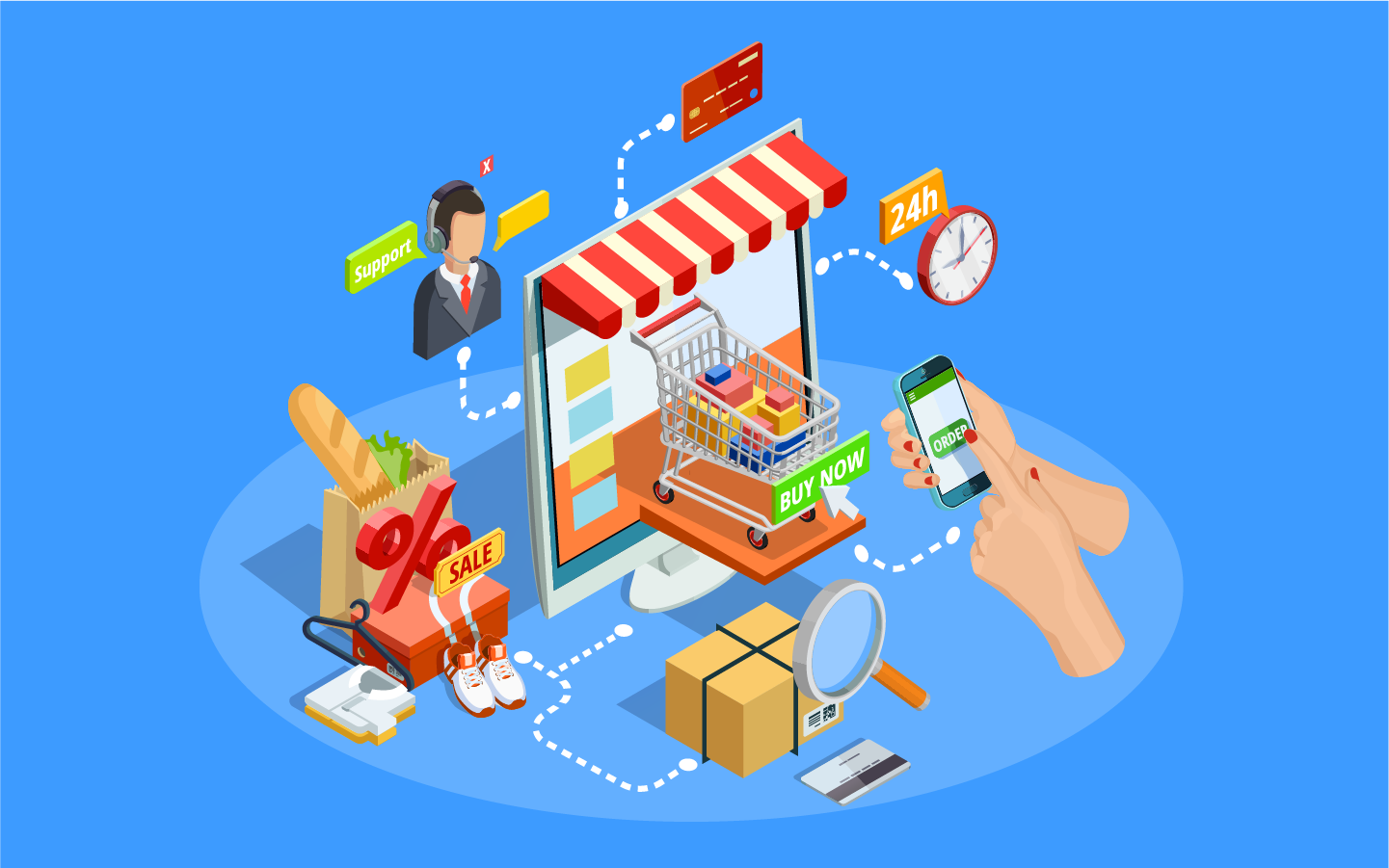
E-commerce Platform Implementation Guide | Key Steps & Tips
B2B Marketing, e-commerce Platforms, Shopify
10 July 2025
- Introduction: Why Does E-commerce Platform Implementation Determine Enterprise Success?
- A Complete Guide to E-commerce Platform Implementation Steps
- Key Success Factors (KSF) for E-commerce Platform Implementation
- Common Problems and Solutions in E-commerce Platform Implementation
- Successful Case Studies in E-commerce Platform Implementation
- Conclusion
- Introduction: Why Does E-commerce Platform Implementation Determine Enterprise Success?
- A Complete Guide to E-commerce Platform Implementation Steps
- Key Success Factors (KSF) for E-commerce Platform Implementation
- Common Problems and Solutions in E-commerce Platform Implementation
- Successful Case Studies in E-commerce Platform Implementation
- Conclusion
1. Introduction: Why Does E-commerce Platform Implementation Determine Enterprise Success?
Choosing the right e-commerce platform is only the beginning. What truly determines whether an enterprise will succeed in digital transformation is how the implementation and integration of the e-commerce system is carried out. Many enterprises fail in the early stages due to insufficient planning or an over-reliance on the technical side, which leads to project delays, cost overruns, and even platforms that do not deliver the expected results.
A successful e-commerce platform implementation is not just about technical deployment, but rather a cross-departmental collaboration for operational upgrading. It requires the involvement of various roles such as IT, marketing, operations, customer service, and finance in the planning and execution process. Based on our practical experience in the Hong Kong and Taiwan markets, more than 60% of implementation failures are not due to incorrect platform selection, but rather a lack of a clear implementation path and organizational support.
This article will break down the complete process of implementing an e-commerce platform from scratch from a practical perspective, including early-stage planning, execution focus, team organization, integration strategy, common mistakes, and key success factors. This will help enterprises avoid pitfalls and launch the platform smoothly, building a competitive digital commerce foundation.
2. A Complete Guide to E-commerce Platform Implementation Steps
Implementing an e-commerce platform is a systemic project that spans strategy, processes, technology, and operations. To help enterprises start successfully from scratch, here are seven core steps to guide you through the planning, execution, and deployment phases, creating an effective and flexible e-commerce infrastructure.
Step 1: Strategic Planning and Requirement Definition
A successful implementation plan begins with the right direction. Enterprises must first clarify the business goals, target audience, and internal resource status for their e-commerce system.
Key Tasks:
- Clearly define goals: such as increasing revenue, enhancing brand, expanding into overseas markets, etc.
- Define the platform's role: Is it a self-operated main site, a supplementary sales channel, or a multi-channel integration?
- Review internal processes and pain points, and create a digital operation blueprint.
- Write requirement documents (FRD), customer process flow diagrams, and content structure drafts.
Step 2: Platform Selection and Vendor Confirmation
A successful implementation plan begins with the right direction. Enterprises must first clarify the business goals, target audience, and internal resource status for their e-commerce system.
Key Tasks:
- Clearly define goals: such as increasing revenue, enhancing brand, expanding into overseas markets, etc.
- Define the platform's role: Is it a self-operated main site, a supplementary sales channel, or a multi-channel integration?
- Review internal processes and pain points, and create a digital operation blueprint.
- Write requirement documents (FRD), customer process flow diagrams, and content structure drafts.
Step 3: UI/UX Design and System Planning
Before system development, complete the full front-end visual design and back-end functional logic, structuring the user experience and operational processes.
Key Tasks:
- Design responsive pages (RWD) that cater to both desktop and mobile shopping experiences.
- Establish shopping processes (Product → Add to Cart → Checkout → Payment → Shipping).
- Define promotional modules, membership systems, and payment logistics integration methods.
- Set up information architecture (IA), API integration rules, and data field formats.
Step 4: System Development and Integration
Formally enter the technical execution phase. It is recommended to develop in modules to ensure clear progress and manageable risks.
Key Tasks:
- Develop front-end and back-end functional modules (Product Management, Order System, Inventory Management, etc.).
- Integrate ERP, CRM, payment gateways, logistics, CDP, and other internal and external systems.
- Develop report and data analysis modules.
- Reserve flexibility for handling change requests.
Step 5: Testing and Acceptance
After system development is complete, a comprehensive testing process must be arranged, including functionality, processes, and security, to ensure the platform is ready for launch.
Key Tasks:
- Functionality Testing (Does the functionality match the original specifications?).
- User Acceptance Testing (UAT) by actual business departments in real-world scenarios.
- Performance and stress testing to verify platform stability under high traffic.
- Security scans and vulnerability patches (SSL, permissions, API controls, etc.).
Step 6: Data Import and Go-Live Preparation
Before going live, product data, customer data, and inventory information must be imported into the platform, and related settings must be completed.
Key Tasks:
- Upload product images, categories, prices, and inventory.
- Create member accounts and permission layers.
- Integrate payment and logistics vendor settings and tests.
- Train internal operators and establish basic operational procedures (SOPs).
Step 7: Go-Live and Operations Monitoring
Once the platform is live, enter the first phase of operational practice. At this point, traffic driving and data monitoring mechanisms should be activated to prepare for subsequent optimization.
Key Tasks:
- Schedule go-live during off-peak or low-risk periods and reserve rollback mechanisms.
- Set up GA4, Adobe Analytics, Meta Pixel, and other tracking tools.
- Continuously monitor order processes, error reports, and user feedback.
- Launch marketing campaigns and traffic tests.
Summary
From strategy, design, development, testing to operations, every step is critical to the overall success of the project. Enterprises not only need professional technical implementation but also internal collaboration and process restructuring. It is recommended to start with a “small but stable” MVP model and gradually expand functionalities and markets to reduce risks and increase investment returns.
3. Why Do Some Enterprises Succeed in E-Commerce Implementation, While Others Fail? — Analysis of Six Underlying Factors
Although implementing an e-commerce platform may seem like a technical project, it is actually a reflection of the company’s culture, organizational readiness, and decision-making quality. After analyzing dozens of e-commerce implementation cases in Hong Kong and Taiwan, we found that the difference between success and failure often lies not in technical performance, but in whether the following underlying factors are in place:

1. Decision-making perspective: Business-driven vs IT-driven
Successful enterprises often approach platform planning from a "business needs" perspective, such as improving conversion rates, reducing customer service pressure, or expanding into overseas markets. In contrast, unsuccessful enterprises are often driven by IT, focusing on technical specifications and system compatibility, neglecting customer experience and business logic.
Reflective Question:
Is your implementation aimed at optimizing the user experience or just "replacing a system"?

2. Are expectations for platform implementation reasonable?
Some enterprises expect to implement all features at once, which leads to scope creep, budget overruns, and project delays. Successful cases typically adopt an MVP (Minimum Viable Product) approach, launching key processes first and optimizing later.
Guideline:
Focus on stable platform deployment first, then move on to optimization and expansion, with a 70% mature, 30% flexible approach.

3. Choosing the right partners
E-commerce platform implementation cannot be completed by a single department. One of the critical success factors is finding the right implementation partner or consultant. Failures often stem from working with outsourced teams lacking industry experience and process thinking.
Evaluation Criteria:
Does the partner understand your business logic? Can they provide local cases? Will they educate your team?
4. Is the organization ready for digital transformation?
Some enterprises struggle to operate e-commerce platforms after implementation because they still follow old processes and mindsets, unable to adapt to the new workflows and speed that the platform requires.
Key Advice:
Establish a dedicated e-commerce operations team, redesign SOPs, performance indicators, and inter-department collaboration methods.
5. Can the operations team run independently?
After technical implementation, if the internal team cannot operate the system, upload products, handle orders, and run promotional activities, the enterprise will continue to depend on external support, losing flexibility.
Necessary Conditions:
Complete full team training and system operation drills within one month of implementation and establish an "internal support team."

6. Do you have a culture and mechanism for continuous optimization?
Truly successful e-commerce platforms are "continuously iterated." Failed cases often stop improving after launch, leading to stagnation in results.
Success Factors:
• Establish tracking indicators (such as conversion rate, bounce rate, average shopping time)
• Hold monthly cross-department review meetings to discuss platform performance and revision suggestions
• Regularly review operational effectiveness and technical maintenance with implementation consultants
4. Common Implementation Problems and Solutions
Even with a clear implementation plan and proper platform selection, businesses will still encounter various challenges and mistakes during the actual e-commerce platform implementation process. The following are the six most common problems faced by enterprises in Hong Kong and Taiwan, along with corresponding solutions to reduce trial and error and improve implementation success rates.
Problem 1: Constantly Adding Requirements Leading to Project Delays and Budget Overruns
Many e-commerce implementation projects fail to control the scope of requirements, resulting in new features being added continuously, causing delays and budget overruns.
Solution:
- At the beginning of the project, establish an MVP (Minimum Viable Product) strategy and prioritize core functions, expanding gradually.
- All new requirements should go through a formal change approval process to assess their impact on the schedule and cost.
- Categorize feature priorities into "must-have," "should-have," and "can-delay" levels.

Problem 2: Poor User Experience Leading to Low Conversion Rates
Although the system launches smoothly, a poor shopping process, inaccurate search features, or a complicated checkout process can cause customer abandonment and missed revenue opportunities.
Solution:
- Introduce professional UI/UX designers to help plan the interface and process.
- Conduct user testing before the launch to identify pain points and abandonment causes.
- Simplify and optimize the shopping cart, product search, and checkout process.

Problem 3: Data Integration Errors Affecting Inventory and Order Management
When integrating the platform with ERP, CRM, and logistics systems, inconsistent data formats or synchronization errors can lead to inventory discrepancies, shipping delays, or missing customer data.
Solution:
- Ensure clear control over data structures and synchronization mechanisms between different systems.
- Develop data flow diagrams and field mapping tables before development.
- For complex integrations, use middleware systems or API gateways to perform data transfer and cleansing.

Problem 4: Communication Gaps Between Development and Business Teams
Business teams' requirements may be misunderstood by the technical teams, resulting in a solution that does not meet actual business needs, leading to wasted time and resources.
Solution:
- Establish a "Product Owner" role to coordinate understanding between business and development teams.
- All requirements should be translated into specific use cases and process flowcharts.
- Each development phase should include acceptance previews, with the business side confirming whether the output meets expectations.
Problem 5: Inability to Operate the Platform Post-launch
Many businesses discover after launch that internal users are not familiar with the platform's backend, making product uploads, promotional setup, and order management difficult, leading to inefficiency and reliance on manual processes.
Solution:
- Conduct multiple training sessions before launch to familiarize users with the platform.
- Develop operation manuals, tutorial videos, and FAQ documents for easy reference and self-learning.
- Modularize backend processes and assign roles and permissions according to user roles.

Problem 6: Lack of Operational Monitoring and Ongoing Optimization
Many companies stop investing in their platforms after launch and fail to monitor data and user behavior continuously, making it difficult to detect issues and optimize the platform, leading to stagnant performance.
Solution:
- Implement data tracking tools (such as GA4, Adobe Analytics, Hotjar) for traffic and behavior analysis.
- Set up dashboards and regular operational reports to monitor key indicators like conversion rate, bounce rate, and traffic sources.
- Hold quarterly review meetings with implementation partners to adjust strategies and priorities.
5. Success Case Studies: From Platform Integration to Brand Upgrade
E-commerce platform implementation is a complex challenge that integrates both technology and operations. Real-world case studies provide concrete examples and reference points. Below are two cases from Hong Kong and Taiwan, representing the integration of systems for large enterprises and the global expansion of a designer brand, showcasing the diverse impacts and strategic value of e-commerce platform implementation.
Case 1: Integrating AEM and Magento to Build a Diversified Online Shopping Platform in Hong Kong
Company Background:
This Hong Kong-based telecommunications company aims to provide a multifaceted online platform combining content, communication, and shopping. The challenge was integrating Adobe AEM (content management) with Magento (e-commerce) to deliver a seamless user experience and efficient platform.
Implementation Focus:
- Integrating AEM with Magento to enable seamless content and product display
- Using responsive HTML technology to improve performance across mobile and desktop devices
- Creating reusable AEM components to reduce future maintenance and operational costs
- Successful integration of AEM with Magento, enhancing frontend consistency and shopping guidance efficiency
- Improved user interface design, boosting conversion rates and customer engagement
- Demonstrated the flexibility and enterprise-level stability of Adobe Experience Cloud
Case 2: Helping a Designer Brand Build a Shopify Store and Successfully Expand to the Global Market
Company Background:
This fashion designer brand, headquartered in Taiwan, offers jewelry, handbags, and footwear. The goal was to leverage digital transformation to expand its global sales channels and enhance brand identity and customer engagement.
Implementation Focus:
- Building a Shopify e-commerce site, combining brand visuals and cross-border shipping capabilities
- Designing promotional modules and time-limited campaigns to convert followers and engage members
- Simplifying the shopping process to enhance user experience and improve conversion rates
- Sales surpassed seven figures within six months, successfully transitioning from a designer brand to an international e-commerce brand
- Increased the influence of the female entrepreneur community and created a female-centered social platform
- Improved customer loyalty, achieving a win-win outcome for both community engagement and business operations
6. Conclusion
Implementing a successful e-commerce platform is far more than just selecting a system; it is a comprehensive business transformation process that spans strategic planning, team collaboration, technical integration, and operational optimization. This article thoroughly analyzes the core concepts and operational key points that enterprises should pay attention to when implementing Adobe Commerce, Shopify, or other platforms, from implementation steps, key success factors, common issues, to real-world case studies.
If enterprises want to improve revenue and strengthen their brand through an e-commerce system, they should start with business goals, select the right platform, establish cross-department teams, seek experienced implementation partners, and continuously perform data analysis and process optimization after launch. This is not just a one-time project but a long-term, sustainable competitive advantage-building effort.
If you are considering implementing an enterprise-level e-commerce platform, especially Adobe Commerce (Magento), we welcome you to learn more about our services and track record: Adobe Commerce Introduction Page
We sincerely invite you to contact us so we can help tailor an e-commerce implementation plan for you: Contact Us Now


